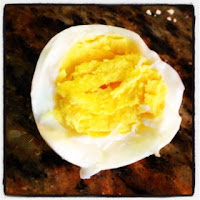Ingredients:
- desired quantity of raw eggs
- 2-4 tsp baking soda. depending on size of pan
- sauce pan large enough to place eggs in a single layer
To cook the eggs:
- Fill sauce pan half way with water and add baking soda.
- Place sauce pan on medium heat, bringing water to a high simmer, just below boil.
- Use a spoon to gently place eggs into the water. When water has returned to a simmer (1-2 minutes) start the timer: 12 minutes for large eggs (subtract 2 minutes for small eggs, or add 2 minutes for extra large eggs).
- Place the entire pan in the sink and run cold water into the pan. When cool enough to handle the pan and water, pour the water out but keep the eggs in the pan. Continue to run cold water over the eggs until they are just cool enough to handle comfortably. Do not let them get too cool or they will be more difficult to peel. Drain the remaining water out of the pan. (You can store them in the refrigerator at this point, if needed, but its easiest to peel them at this point.)
To peel the eggs:
- Tap the broad (bottom) end on the counter firmly.
- Gently roll the egg around its sides on the counter, just enough to crack the shell but not hard enough to squish the egg out of shape at all.
- Peel the shell off at the bottom end.
- Starting at the bottom, gently get your finger tip under the shell and lift it off, working around and towards the top of the egg. Do not pull the shell off from the outside as this will increase the risk of removing a layer of the white flesh along with the shell.
- When the shell if removed, briefly rinse with warm tap water to remove remaining bits of shell.
A perfectly prepared hard egg should be solid, both the white and the yolk, and the yolk should not be overly dry, crumbly or at all tinged with green. If it is too dry, it has been over cooked (too long). If it is green, the water was too high (you boiled it rather than simmering it). The baking soda in the water breaks down the chemical inside the shell that adheres it to the egg and makes it much easier to peel the eggs.
[Note: I tried posting pictures to go with the peeling steps, but Blogger is being a pain and placing them all over the place out of order, so I had to delete them.]


No comments:
Post a Comment